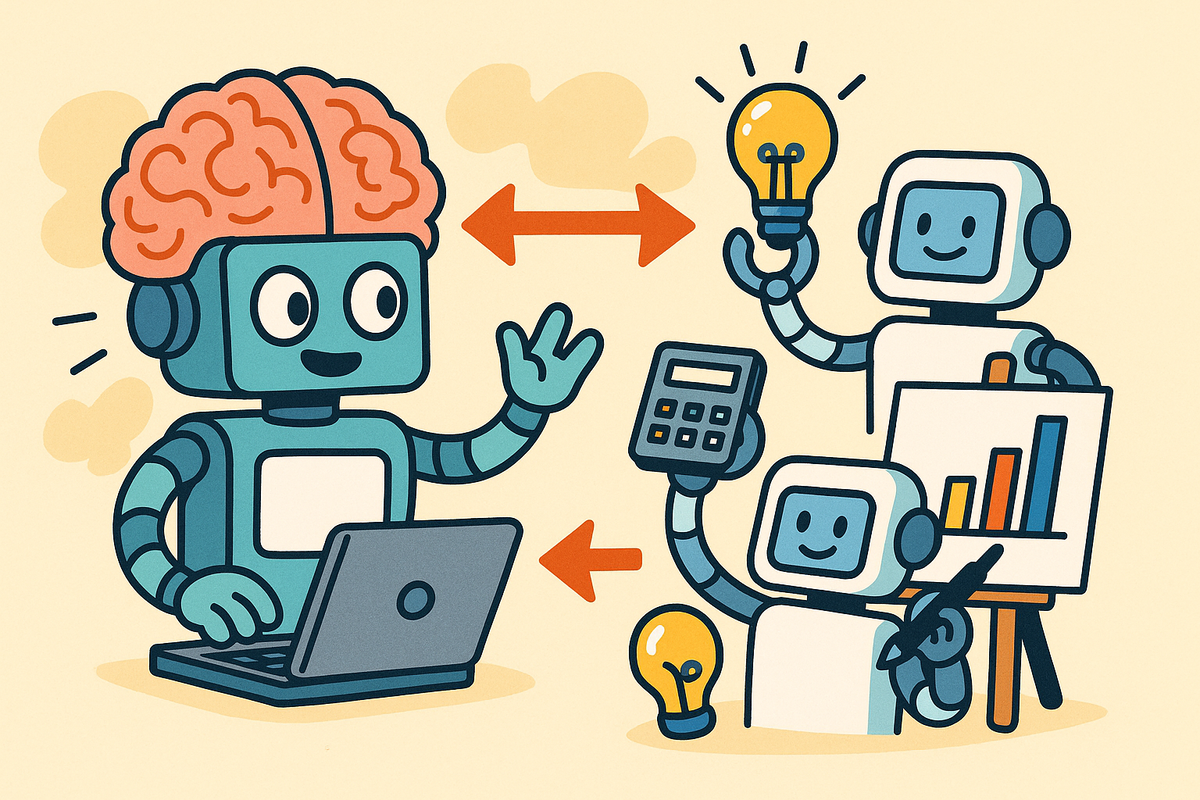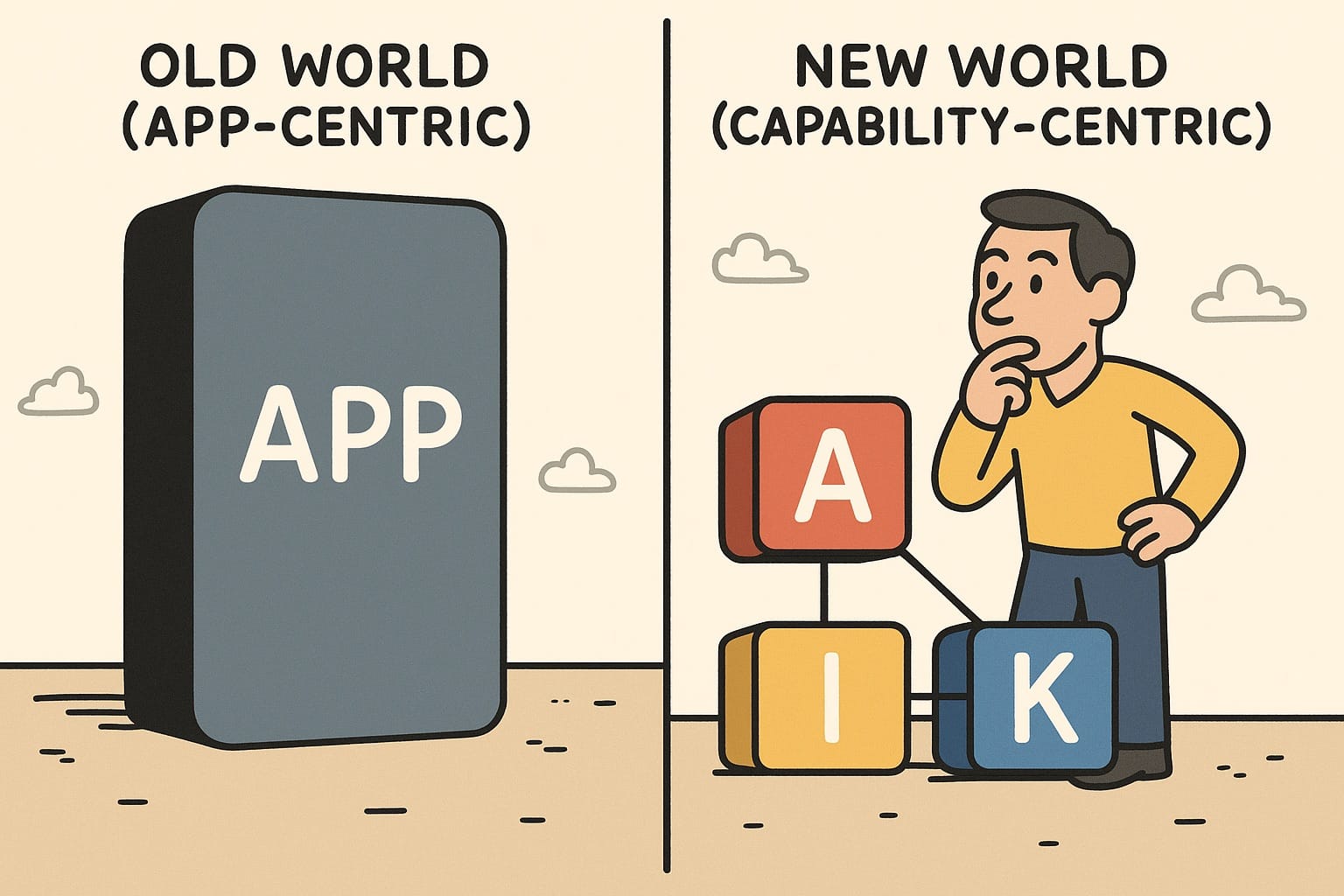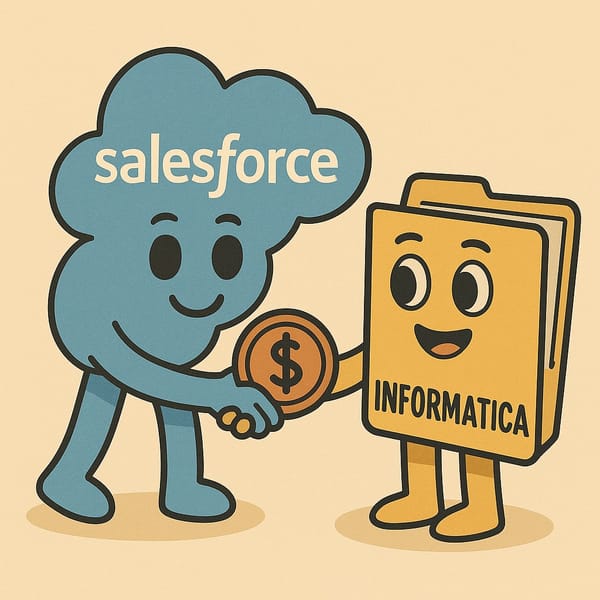The AI That Knows How to Use Other AI
The app store is dead. Long live the agent marketplace.

Remember when your biggest business worry was getting humans to download your app? Those were simpler times. Now you have to worry about getting robots to hire your robot.
Welcome to the strangest job market in history, where artificial intelligence systems are becoming both the workers and the hiring managers, and your SaaS startup is basically running a temp agency for algorithms. If this sounds like science fiction, you haven't been paying attention to your API logs lately.
Something fundamental is shifting beneath the surface of the software industry, and it's happening so quietly that most people are still optimizing for human users while AI systems are busy making those humans irrelevant. We're witnessing the death of the app-centric world and the birth of something far weirder: a marketplace where intelligence itself punches a time clock.
The Great App Store Extinction Event
Let's start with a moment of silence for the traditional SaaS playbook, which served us faithfully from roughly 2008 to last Tuesday.
The old strategy was beautifully simple: build an app, make it sticky enough that humans couldn't escape (like digital flypaper), scale usage until your servers caught fire, then monetize the attention you'd captured. Companies competed on who could create the most addictive user interfaces, the smoothest workflows, and the stickiest engagement loops. Success meant humans logging in, clicking around, and finding your software valuable enough to pay for instead of, say, buying coffee.
This model is about to become as relevant as a Blockbuster Video store in a Netflix world.
Here's why: modern AI systems can coordinate with other AI systems without human supervision. It's like watching middle management get automated, except the middle managers were us and the automation is disturbingly efficient.
Consider the numbers: research shows that monolithic AI systems experience a staggering 320% increase in processing latency when handling intensive AI workloads. Meanwhile, companies implementing composable AI architectures are seeing the opposite—dramatic efficiency gains and cost reductions because they can optimize at the component level rather than rebuilding entire systems.
Consider your typical customer support scenario. In the old world, a human support agent would log into multiple dashboards, copy information between systems, and manually escalate issues while slowly losing their will to live. In the new world, an AI agent automatically routes inquiries, pulls relevant information from knowledge bases, generates responses, updates ticket systems, and probably does your taxes—all without a human opening a single dashboard.
So what exactly are you selling when the buyers are algorithms and the users are algorithms and the only humans left are the ones signing the checks? (For now.)

From "There's an App for That" to "There's an API for That"
The emerging AI ecosystem is organized around what researchers call "composable, modular intelligence"—which is a fancy way of saying AI systems are becoming Lego blocks for robots. Instead of building software that humans struggle to operate, smart companies are building capabilities that AI systems can snap together like digital kindergarteners.
The shift is dramatic:
Old World (The Human Hamster Wheel):
- Build an email marketing platform with 47 different dashboards
- Design workflows complex enough to require a PhD to navigate
- Market to overwhelmed marketing teams who just want to go home
- Revenue from subscriptions that auto-renew while users pray for escape
- Success measured by how long you can keep humans trapped in your interface
New World (The Robot Employment Exchange):
- Build an email optimization capability that actually works
- Expose it through protocols that don't require a user manual
- Market to AI orchestration platforms that never sleep
- Revenue from API calls that scale with actual value delivery
- Success measured by how often AI systems choose your service over your competitors'
This isn't some distant future fantasy. Companies are already implementing AI-first architectures where individual functions—data analysis, content generation, customer interaction—are modular components that can be mixed and matched like ingredients in a very smart smoothie. Enterprise AI trends for 2025 show that the focus is shifting toward specialized language models for agentic AI and the democratization of AI agents through low-code/no-code platforms.
It's like the internet's evolution from static websites to dynamic APIs, except this time the consumers aren't just other software applications—they're intelligent agents that can discover, evaluate, and hire your services without ever asking for a demo.
The Great Protocol Wars (Or: How to Pick the Right Horse in a Race Between Robots)
Just as the early internet needed standards like HTTP and HTML (so we could all argue about the same things), the AI-orchestrated world is developing its own foundational protocols. And boy, are the tech giants having feelings about this.
Model Context Protocol (MCP), Anthropic's entry, is being marketed as "USB-C for AI integrations"—which is either brilliant positioning or a terrifying reminder of how many USB cables we've thrown away over the years. Google has counter-punched with their Agent2Agent Protocol (A2A) for cross-vendor agent communication, because apparently even AI systems need to network.
But here's what's really happening: organizations like NIST are actively developing AI standards to promote innovation and cultivate trust, while international bodies like ISO and ITU are working to establish comprehensive AI frameworks. The protocol wars aren't just corporate positioning—they're the foundation of the next computing era.
For startups, this is like being asked to choose sides in a war where the weapons are acronyms and the battlefield is invisible. Early adoption of the right protocol could provide massive leverage—like being an early web developer who understood HTTP instead of trying to build everything in Flash. But betting on the wrong standard could leave you building for a platform that achieves the digital equivalent of Betamax.
The smart money is on building protocol-agnostic capabilities while monitoring which standards actually get adopted rather than just announced with great fanfare. Think of it as being Switzerland in a world where the warring nations are tech companies with unlimited marketing budgets and questionable naming conventions.
The Trust Fall Economy
Here's what most analysis of AI orchestration gets hilariously wrong: the biggest barrier isn't technical complexity—it's trust. And teaching machines to trust each other is turning out to be surprisingly similar to teaching humans to trust each other, except with more JSON and fewer trust falls.
When AI systems start making autonomous decisions about which services to use, your beautiful website becomes about as relevant as a billboard in a world where everyone drives with their eyes closed. An AI agent doesn't care about your clever copy, your stunning design, or your founder's inspiring origin story. It evaluates capabilities based on cold, hard performance data—like a hiring manager who actually reads resumes instead of just looking at the college names.
This creates competitive dynamics that would make a traditional sales team break out in hives:
- Verifiable Performance: Can you prove your capability works better than alternatives? AI systems will test this through automated benchmarks, not by sitting through your PowerPoint about "revolutionary synergies."
- Transparent Reliability: What's your uptime? Response time? Error rate? These metrics become your primary differentiators, not whether your logo looks trustworthy.
- Integration Friction: How easily can an AI system discover, test, and integrate your capability? The smoother this process, the more likely you are to be chosen—like being the restaurant that takes reservations instead of making people wait in line for three hours.
- Explainable Outputs: When your capability makes a decision, can the orchestrating AI understand why? This becomes crucial for debugging, which is important because nobody wants to explain to their boss that the AI made a mistake for mysterious reasons. Research in explainable AI is developing techniques like layered prompting to make multi-agent decision-making more transparent.
The companies building this trust infrastructure—the platforms that verify capabilities, benchmark performance, and provide reliability guarantees—may capture enormous value. Think of them as the Yelp for robot services, except the reviews are written by other robots and actually mean something. Best practices for implementing agentic AI emphasize the importance of continuous monitoring, human-in-the-loop controls, and standardized evaluation metrics.
The Orchestration Gold Rush
While everyone's busy building individual AI capabilities (the digital equivalent of artisanal pickaxes), there's a massive opportunity in becoming the system that coordinates them all. Research shows that enterprises are drowning in a "growing web of tools" with all the coordination of a middle school band.
The real challenge isn't technical—it's architectural. Studies of multi-agent systems show that the biggest challenge lies in maximizing agent utilization while aligning individual tasks with overall goals. It's like being a conductor for an orchestra where the musicians are robots, they all speak different languages, some occasionally break mid-performance, and the audience consists of other robots who are very particular about tempo.
This breaks down into several delightful challenges:
- Discovery: How do AI systems find the right capability for a task? It's like Yellow Pages for robots, except useful.
- Evaluation: How do they choose between competing options? Imagine if comparison shopping was done by systems that can actually read the fine print.
- Coordination: How do they manage complex workflows involving multiple capabilities? Think project management, but the team members are algorithms with perfect attendance but occasional existential crises.
- Error Handling: What happens when one component fails? Someone has to be the adult in the room when the robots start arguing.
- Cost Management: How do they optimize for performance vs. expense? Finally, purchasing decisions made by entities that don't have corporate credit cards.
Companies like CrewAI, LangChain, and Microsoft AutoGen are early players, but the space is about as crowded as a ghost town. Academic research on multi-agent frameworks shows significant productivity gains in early implementations, particularly in financial services where AI agents are already driving measurable ROI through automated fraud detection and risk management. The winning approach likely involves becoming indispensable to the workflow rather than just providing another tool that gets lost in the digital equivalent of a junk drawer.
The New Competitive Landscape (Or: How to Win When Nobody Knows the Rules Yet)
Traditional SaaS competition was like a civilized tennis match: predictable rules, clear scoring, and everyone wore white. AI-era competition is more like Calvin-ball: the rules change constantly, nobody's sure who's winning, and the only constant is chaos.
The old competition was about feature parity and user experience. The new competition is about becoming the preferred component in AI-orchestrated workflows—like being the Intel inside, except instead of computers, it's inside the thoughts of artificial minds.
This changes everything about go-to-market strategy in ways that would make a traditional marketing team weep:
- Sales Cycles: Instead of convincing humans through demos and relationship building, you need to convince AI systems through performance data and ease of integration. The "sales process" becomes largely automated, which is either terrifying or liberating depending on how much you enjoyed cold calling.
- Market Research: User interviews matter less than understanding which AI orchestration platforms are gaining adoption and what capabilities they desperately need. Focus groups are out; API analytics are in.
- Product Development: Feature roadmaps should prioritize API completeness and reliability over making the interface prettier. Nobody cares if your dashboard is beautiful if robots can't use it.
- Pricing Strategy: Usage-based pricing becomes essential because AI systems will optimize for cost-effectiveness with the ruthless efficiency of a coupon-clipping grandmother.
- Marketing: Content marketing shifts from educating human buyers to helping AI systems discover and understand your capabilities. SEO becomes API discoverability, which sounds less exciting but is probably more important. Think of it as building for an audience that reads every line of your documentation and never forgets inconsistencies.
The Platform Play (Or: Building the Amazon for Algorithms)
The most intriguing strategic opportunity might be becoming the platform where AI capabilities are discovered, evaluated, and orchestrated. This is the "app store for AI agents" play, except the dynamics are fundamentally different because robots shop very differently than humans do.
Unlike human users who browse apps like they're wandering through a digital mall, AI systems will programmatically evaluate capabilities based on:
- Performance benchmarks (robots love spreadsheets)
- Cost efficiency (robots are surprisingly thrifty)
- Integration complexity (robots hate unnecessary complications)
- Reliability history (robots have perfect memory for grudges)
- Use case fit (robots are surprisingly picky)
The platform that creates the best marketplace for these automated evaluations—complete with standardized testing, performance analytics, and seamless integration—could become enormously valuable. It's like building a hiring platform for a world where everyone is a freelancer and all the HR managers are algorithms.
But here's the catch that makes this interesting: this platform needs to solve the coordination problem that current AI systems face when working together. It's not enough to list capabilities like a digital phone book; you need to facilitate actual collaboration between systems that may have never worked together before.
Security considerations add another layer of complexity—when AI systems are making autonomous decisions about which services to trust, traditional security models break down. The winning platform will need to solve authentication, authorization, and audit trails for a world where the users are algorithms.
The Transition Strategy (Or: How to Change Horses Mid-Stream Without Drowning)
For existing SaaS companies, transitioning to this new world requires the strategic equivalent of changing the engine on a plane while it's flying. You can't abandon your human users overnight (they're still paying the bills), but you also can't ignore the AI-orchestrated future (it's coming whether you're ready or not).
The smart approach is a gradual migration that won't give your board of directors heart palpitations:
- Phase 1: API-First Architecture Rebuild your core functionality as APIs that can be consumed by both your traditional interface and AI systems. This provides optionality without disrupting existing revenue, like having a backup parachute that may or may not be necessary.
- Phase 2: Agent-Friendly Interfaces Implement the emerging AI protocols and make your capabilities discoverable to AI orchestration platforms. Start capturing usage data from AI-driven workflows, because data is the new oil and robots are apparently very thirsty. Interoperability standards are becoming crucial for unlocking the full potential of agentic AI.
- Phase 3: AI-Native Features Build capabilities specifically designed for AI consumption—standardized inputs/outputs, deterministic behaviors, comprehensive error handling, and performance guarantees. Think of it as writing code for the most literal-minded users imaginable.
- Phase 4: Orchestration Capabilities Begin offering orchestration services yourself, combining your core capabilities with complementary ones to provide complete AI-driven workflows. Become the conductor of your own robot orchestra.
The companies that navigate this transition successfully will be those that recognize it's not just a technology shift—it's a complete reimagining of how software creates and captures value, like the difference between selling horses and selling cars.
The New Ecosystem Players (Or: Who's Who in the Robot Zoo)
Understanding the emerging ecosystem is crucial for positioning your startup correctly. The landscape is organizing around several key roles, like a very specialized high school:
- Foundation Model Providers (OpenAI, Anthropic, Google) are the popular kids who provide the general intelligence that orchestrates everything else.
- Specialized Capability Providers are the subject matter experts—they build domain-specific AI services for fraud detection, image analysis, content generation, and legal research.
- Orchestration Platforms (CrewAI, LangChain, AutoGen) are the student council, facilitating coordination between all the different cliques.
- Integration Infrastructure companies are the IT department, providing the APIs and protocols that enable communication.
- Trust and Verification Services are the hall monitors, benchmarking capabilities and providing reliability guarantees.
The winning strategy depends on which role you choose and how well you execute within that niche. But the biggest opportunities may lie in roles that don't exist yet—the ones that emerge from the unique challenges of getting artificial minds to work together productively.
Real-world case studies are already showing impressive results: H&M's AI agents increased e-commerce conversions, Bank of America's Erica has handled over a billion interactions while saving millions in operational costs, and Lufthansa's customer service agents have dramatically improved response times.
The Ultimate Disruption (Or: Why Everything You Know Is Wrong Again)
What we're witnessing isn't just another platform shift, like going from desktop to mobile. It's the fundamental restructuring of how software creates value, which sounds dramatic but is probably accurate.
In the app era, value came from aggregating human attention and optimizing for engagement—basically, being as addictive as possible without technically being illegal. In the AI era, value comes from providing reliable, discoverable capabilities that can be orchestrated autonomously—being useful rather than just sticky.
This changes the entire startup playbook in ways that business schools haven't even started teaching yet:
- User acquisition becomes capability discoverability
- Product-market fit becomes agent-capability fit
- Growth metrics shift from user engagement to orchestration frequency
- Monetization moves from subscriptions to usage-based pricing
- Competitive moats come from reliability and integration ease, not feature differentiation
The companies that understand this shift early—and position themselves correctly within the emerging ecosystem—will have massive advantages over those still optimizing for human users in a world increasingly orchestrated by artificial intelligence. Research on AI trends for 2025 shows a strategic shift toward decision automation and intelligence as enterprises move AI proof-of-concepts into production.
We're not just watching the birth of smarter software. We're watching the birth of software that doesn't need us to operate it. And that changes everything about how we build, market, and monetize the tools that power our economy.
The age of apps is ending. The age of capabilities is just beginning. And frankly, it's about time—I was getting tired of remembering all those passwords anyway.




